Chapter 13: Positive Emotions
Broaden and Build Theory of Positive Emotions
Figure 23
Broaden-and-Build Theory of Positive Emotions
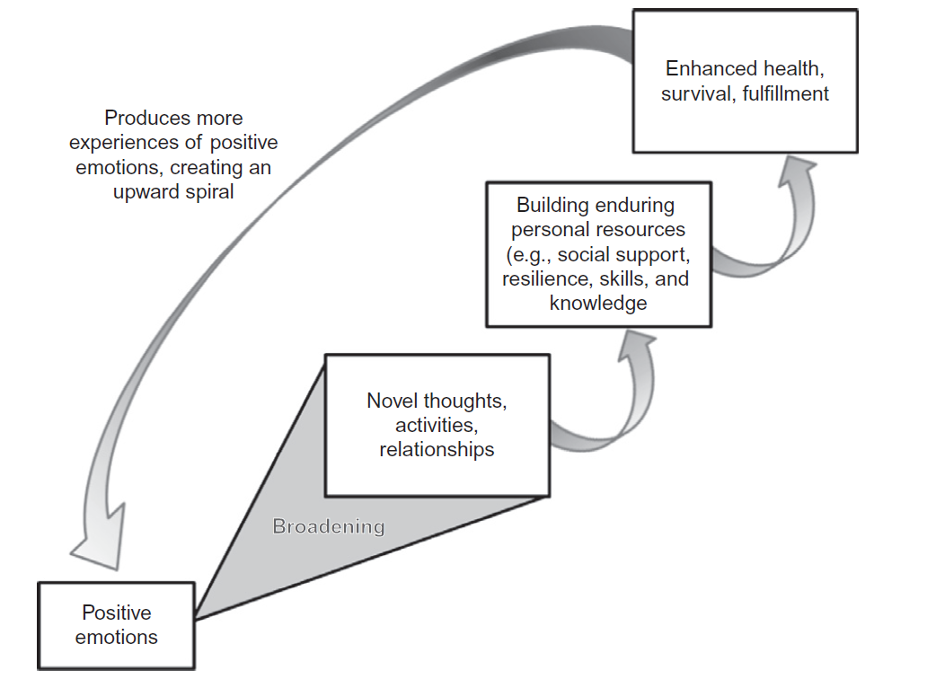
Long Description
The image is a diagram depicting the upward spiral effect of positive emotions. It consists of several interconnected shapes and arrows. At the bottom left, there is a box labeled “Positive emotions.” An arrow points right to a triangle labeled “Broadening” with the text “Novel thoughts, activities, relationships.” Another arrow curves from the triangle to a rectangular box labeled “Building enduring personal resources (e.g., social support, resilience, skills, and knowledge).” A further arrow curves up to a top-right box labeled “Enhanced health, survival, fulfillment.” Finally, an arrow curves from this top box back to the initial “Positive emotions” box, illustrating a cyclical process. To the left, a curved arrow has the text “Produces more experiences of positive emotions, creating an upward spiral.”
Reproduced from “Positive emotions broaden and build,” by B.L. Fredrickson, In P. Devine and A. Plant (Eds.) Advances in Experimental Social Psychology, 47, p. 16, Copyright 2013 Academic Press. Adapted from “Positive emotions” by B.L. Fredrickson and M.A. Cohn, , 2008, In M. Lewis, J.M. Haviland-Jones, and L.F. Barrett Handbook of Emotions (3rd Edition, p. 783). Copyright 2008 Guilford Press.
Fredrickson and Cohn (2008, p. 782) define the broaden-and-build theory as:
Let’s break down this definition.
Table 25
Cognitive and Behavioral Responses Caused by Specific Positive Emotions
| Positive Emotion | Broadened and Flexible Cognitive and Behavioral Responses |
|---|---|
| Joy | Urge to play, push limits, be creative |
| Interest | Urge to explore, take in new information and experiences, and explain the self |
| Contentment | Urge to sit back and savor current life circumstances; integrate new views of self and world |
| Love | Urges to play with, explore, and savor loved ones. |
Adapted from “Positive emotions” by B.L. Fredrickson and M.A. Cohn, , 2008, In M. Lewis, J.M. Haviland-Jones, and L.F. Barrett Handbook of Emotions (3rd Edition, p. 782). Copyright 2008 Guilford Press.
Evidence for the Broaden Hypothesis
The broaden hypothesis states: “Positive emotions broaden the scopes of attention, cognition, and action, widening the array of percepts, thoughts, and actions presently in mind” (Fredrickson & Branigan, 2005 p. 315)
The narrow hypothesis states that negative emotions narrow attention to focus on the threat in the environment.
Studies have confirmed the broaden hypothesis by demonstrating that positive emotions cause greater awareness of the visual field and by showing that positive emotions cause people to process information at a more global (vs. detailed) level.
Fredrickson and Branigan (2005) tested the broaden hypothesis in two experiments. In experiment 1, participants were randomly assigned to watch one of five watched film clips to elicit an emotion. Two clips elicited a positive emotion (amusement, contentment/serenity), two clips a negative emotion (anger/disgust, anxiety/fear), and one clip a neutral state. After watching their assigned film clip, participants completed the visual processing task. After completing the experimental tasks, participants reported their subjective feelings.
In the Experiment 1 visual processing task, participants were shown a standard image and two possible response options – A or B (see Figure 24). In the example below, the standard image is three square elements that together make up a triangle. Participants were asked if the standard image was more similar to the A or B figure. The A figure represented broadened attention because globally the standard image shows a triangle. The B answer represented narrowed attention because the narrow/smaller details in the standard image are squares. For each participant, the number of times they selected the broadened answer was summed. Higher scores, therefore, indicate greater broadened processing.
Figure 24
Visual Processing Task (Fredrickson & Branigan, 2005)

Long Description
The image depicts a visual processing task. At the top center, there is a “Standard Image” consisting of three black squares arranged in a pyramid shape, with two squares at the bottom and one centered above them. Below, two options labeled A and B are presented. Option A, labeled “Broadened Answer,” features three black triangles arranged to form the shape of an upright triangle. Option B, labeled “Narrow Answer,” contains four black squares arranged in a 2×2 grid. Text below the standard image asks, “Is A or B more similar to the standard image?”
Reproduced from “Positive emotions broaden the scope of attention and thought‐action repertoires” by B.L. Fredrickson and C. Branigan, 2005, Cognition & Emotion, 19(3), p. 317 (https://doi.org/10.1080/02699930441000238)Copyright 2005 by Psychology Press
Figure 25
Broadened Processing Scores for 5 Elicited Emotions (Experiment 1; Fredrickson & Branigan, 2005)
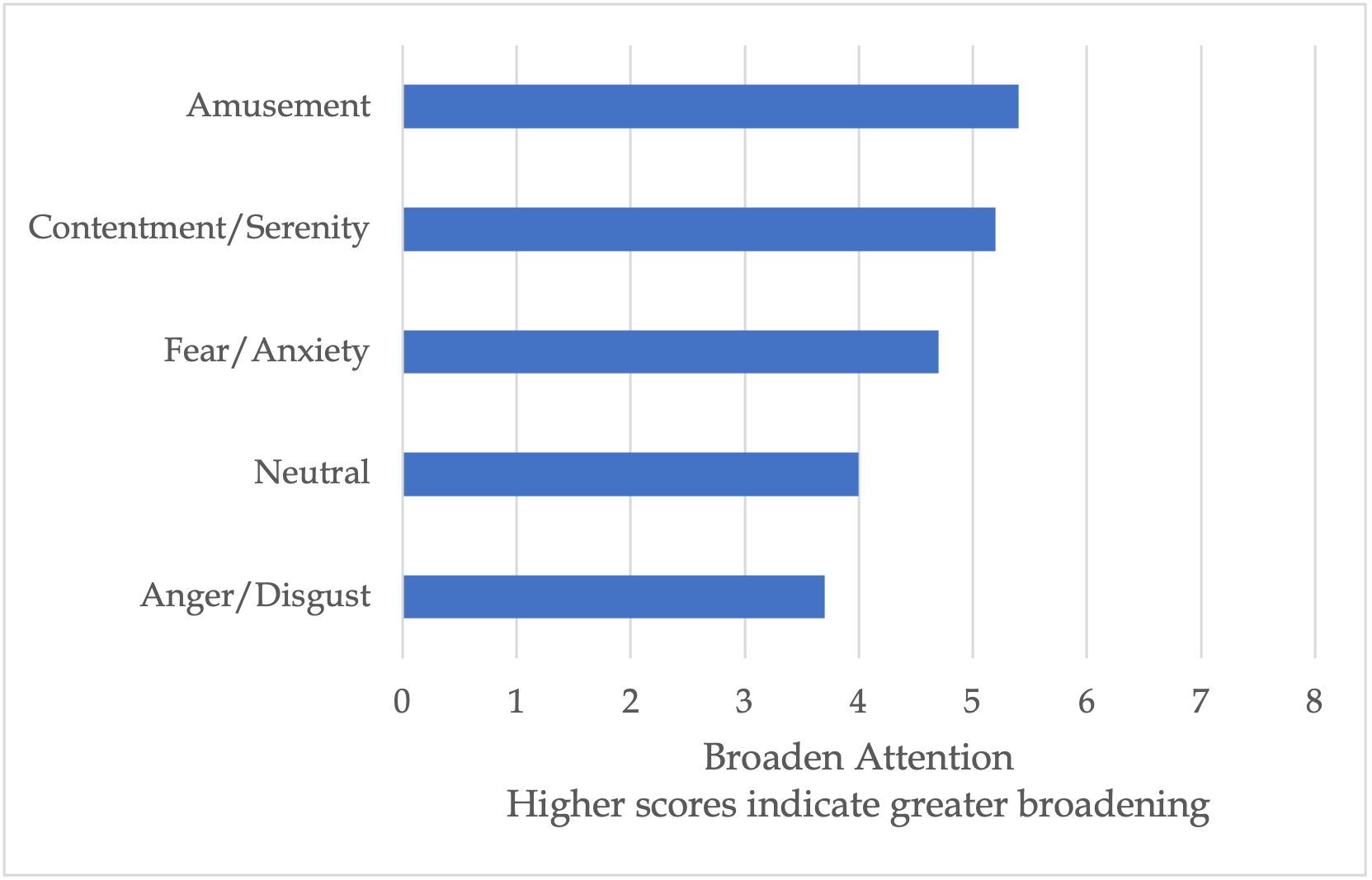
Long Description
The image is a bar graph displaying the broaden attention scores for five different emotions. The x-axis represents the broaden attention scores ranging from 0 to 8. The y-axis lists the emotions as follows from top to bottom: Amusement, Contentment/Serenity, Fear/Anxiety, Neutral, and Anger/Disgust. Each emotion has a corresponding horizontal blue bar indicating its score on the broaden attention scale. Amusement has a score of approximately 7.5; Contentment/Serenity has a score of approximately 6; Fear/Anxiety has a score of approximately 5; Neutral has a score of approximately 4; Anger/Disgust has a score of approximately 3. At the bottom of the graph is an explanatory note stating “Higher scores indicate greater broadening.”
Reproduced from “Positive emotions broaden the scope of attention and thought‐action repertoires” by B.L. Fredrickson and C. Branigan, 2005, Cognition & Emotion, 19(3), p. 323 (https://doi.org/10.1080/02699930441000238)Copyright 2005 by Psychology Press
In Experiment 2, the same participants were randomly assigned to one of the remaining four clips they had not viewed. After participants viewed their assigned clip, they provided one or two words to describe their emotion and then completed the Twenty Statemen Test (TST; Kuhn & McPartland, 1954). In the Twenty Statements Test, participants were instructed to imagine being in the film clip and respond to twenty statements that started with “I would like to .” Higher scores indicated more broadened behaviors. Experiment 2 ended with participants again self-reporting their subjective feelings.
Similar to Experiment 1, Figure 26 shows that the amusement clip resulted in greater broadened behaviors than the neutral clip and the contentment/serenity clip approached significance (p = .109). When both positive (amusement, contentment) clips were added together, they showed more broadening than the neutral clip and the two negative emotion clips added together. Fredrickson and Branigan (2005) stated that findings support the broadening and narrow hypotheses. But, only the anger/disgust clip showed greater narrowing than the neutral clip. The fear/anxiety clip was not different from the neutral clip.
Figure 26
Broadened Behaviors Scores for 5 Elicited Emotions (Experiment 2; Fredrickson & Branigan, 2005)
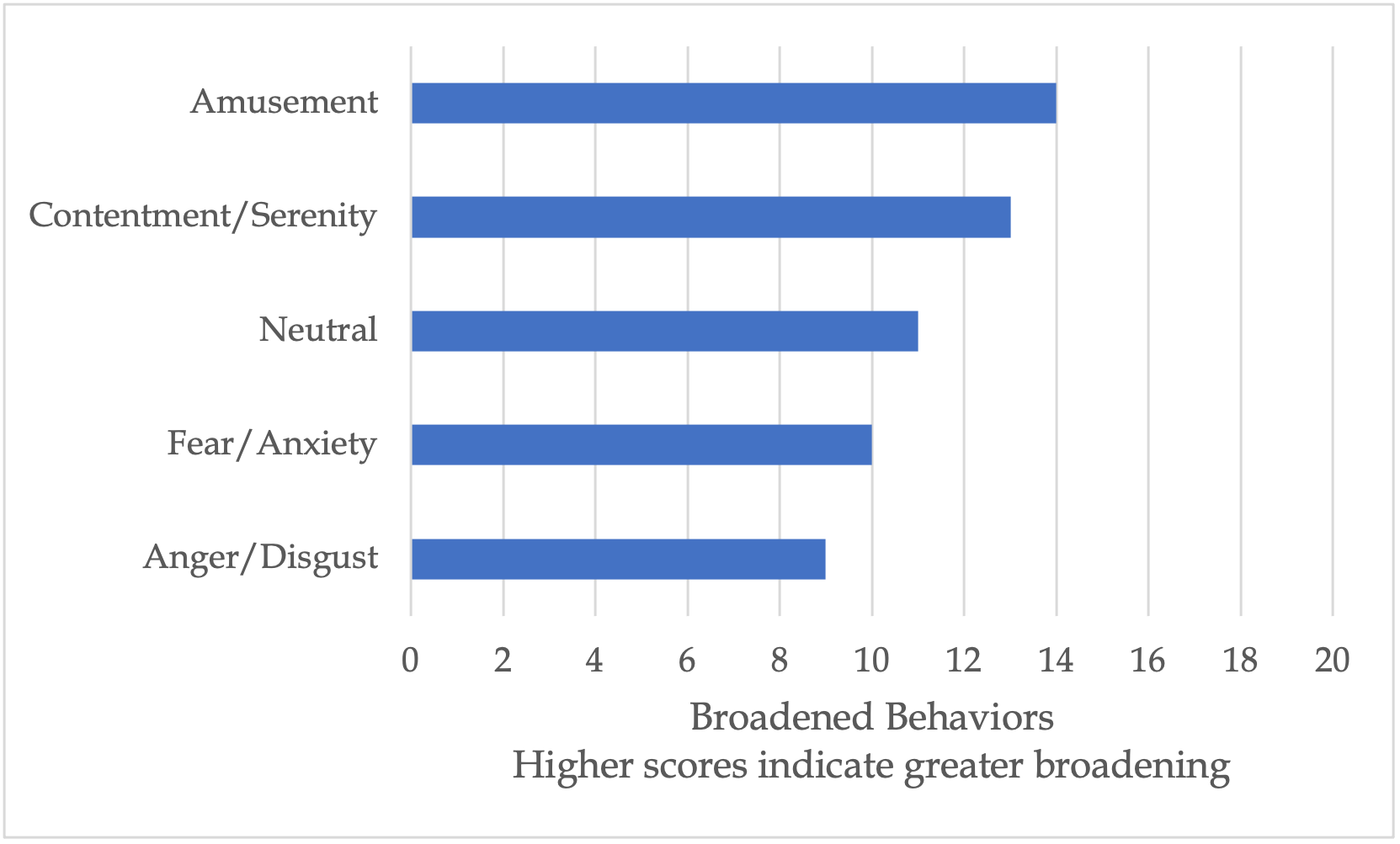
Long Description
The image is a horizontal bar graph that illustrates how different emotional states correlate with broadened behaviors. The x-axis is labeled “Broadened Behaviors” and ranges from 0 to 20. The y-axis lists five emotional states: Amusement, Contentment/Serenity, Neutral, Fear/Anxiety, and Anger/Disgust. Each emotional state has a corresponding blue bar indicating its score on the broadened behaviors scale:
- Amusement has a score of approximately 18.
- Contentment/Serenity has a score of approximately 16.
- Neutral has a score of approximately 14.
- Fear/Anxiety has a score of approximately 12.
- Anger/Disgust has a score of approximately 10.
A caption below the x-axis reads: “Higher scores indicate greater broadening.”
Reproduced from “Positive emotions broaden the scope of attention and thought‐action repertoires” by B.L. Fredrickson and C. Branigan, 2005, Cognition & Emotion, 19(3), p. 324 (https://doi.org/10.1080/02699930441000238)Copyright 2005 by Psychology Press
The researchers also coded the participants responses to the Twenty Statements Test and then analyzed differences in answers for the positive, negative, and neutral film clip conditions. Compared to the neutral condition, participants who watched positive film clips exhibited a greater desire for the following approach behaviors:
- Outdoor/nature activities
- Exercise/Sports
- Desire to play
- Desire to have positive thoughts
- Less Desire to Sleep/Rest
Compared to the neutral condition, participants who watched negative film clips exhibited the following desires:
Lowered desire to:
- eat/drink
- reminisce
- complete work/school tasks
- read
Greater desire to be antisocial for anger/disgust clip and to be around others for fear/anxiety clip.
Fredrickson and Cohn (2008) cite additional work that provides examples of broadening thoughts and behaviors. Below, Table 26 lists these examples with the citations.
Table 26
Examples of Broadened Thoughts and Behaviors (Fredrickson & Cohn, 2008)
| Broadened Thought / Behavior | Citation |
|---|---|
| Creative thoughts | Isen, Daubman, & Nowicki, 1987 |
| Open to learning new information | Estrada et al., 1997 |
| Improved Verbal Performance | Rowe, Hirsch, & Anderson, 2007 |
| More self-overlap with relationship partners | Waugh & Fredrickson, 2006; Waugh et al., 2006) |
| Increased Trust | Dunn & Schweitzer, 2005 |
| Reduces “Us versus Them” mindset | Dovidio, Gaertner, Isen, Rust, & Guerra, 1995) |
| Improved memory for faces of other races and reduced ability to identify physical differences between two races | Johnson & Fredrickson, 2005 |
Adapted from “Positive emotions” by B.L. Fredrickson and M.A. Cohn, , 2008, In M. Lewis, J.M. Haviland-Jones, and L.F. Barrett Handbook of Emotions (3rd Edition, p. 784-785). Copyright 2008 Guilford Press.
Evidence for the Build Hypothesis
The build hypothesis states “…temporary and transient experiences of positive emotions, by encouraging a broadened range of actions, over time build enduring personal resources” (Fredrickson & Cohn, 2008 p. 785)
To test the build hypothesis, Fredrickson and colleagues (2008) developed a meditation intervention to demonstrate how positive emotions over time can build personal resources, and in turn, impact life satisfaction. Participants were randomly assigned to a meditation intervention or a control group. For the meditation group, participants were trained in the Loving Kindness Meditation (LKM), which broadens mindsets using the positive emotions of love and compassion. For an example of LKM, visit Fredrickson’s Positivity Resonance page. This page includes examples of other meditations she has developed. In LKM, participants started by expressing love and compassion toward the self, then expanded to close others, acquaintances, and strangers. Participants were instructed to practice LKM at least five days per week for eight weeks. Including the baseline period, the study lasted for a total of 9 weeks.
The second independent variable was time. First, baseline measures were completed followed by 8 weeks of experimental meditation or control sessions.
At each time period, several dependent variables were measured. During the 9-week study, participants completed self-report measures of 9 positive emotions: amusement, awe, contentment, joy, gratitude, hope, interest, love, and pride, and 8 negative emotions: anger, shame, contempt, disgust, embarrassment, guilt, sadness, and fear. Using various self-report measures, participants reported on their personal resources. 18 personal resources were divided into four categories – cognitive, psychological, social, and physical. See Tables 27 through 30 for the measures of personal resources. Two outcome measures – depression and satisfaction with life – represented the outcome variables.
Table 27
List of 6 Cognitive Personal Resources Measured (Fredrickson et al., 2008)
| Type of Cognitive Personal Resource | Definition of Measure |
|---|---|
| Mindfulness and Awareness | the act of not being mindless or not acting on “autopilot”; focusing attention environment and one’s own actions |
| Agency Thinking | belief that one is able to achieve goals |
| Pathways Thinking | belief that multiple ways exist to achieve one’s goals |
| Savoring the Present | Enjoying current experiences |
| Savoring the Past | Enjoying the recall of past experiences |
| Savoring the Future | Enjoying the anticipation of future good experiences |
Table 28
List of 8 Psychological Personal Resources Measured (Fredrickson et al., 2008)
| Type of Psychological Personal Resource | Definition |
|---|---|
| Optimism | Expecting more good than bad events to happen to oneself |
| Resilience | Ability to bounce back from challenges |
| 6 Psychological Well-being Measures | Personal Growth, Environmental Mastery, Autonomy, Self-Acceptance, Purpose in Life |
Table 29
List of 2 Social Personal Resources Measured (Fredrickson et al., 2008)
| Type of Social Personal Resource | Definition |
|---|---|
| Social Support from Close Others | Amount of social support received from close others |
| Positive Relationships with Others | High trust of others, low loneliness |
Table 30
List of 2 Physical Personal Resources Measured (Fredrickson et al., 2008)
| Type of Physical Personal Resource | Definition |
|---|---|
| Physical Illness Symptoms | Few symptoms |
| Sleep Duration | Lots of sleep! |
Reproduced from “Open hearts build lives: Positive emotions, induced through loving-kindness meditation, build consequential personal resources” by B.L. Fredrickson, M.A. Cohn, M.A., K.A. Coffey, J.Pek, and S. M. Finkel, Journal of Personality and Social Psychology, 95 2008, (5), p. 1049-1050 (https://doi.org/10.1037/a0013262) Copyright 2008 by the American Psychological Association.
The first important analysis used time and experimental group as the independent variable predicting the amount of the 9 positive emotions averaged together (Figure 27). Time was a significant predictor of positive emotions for the LKM group, but not the control group. As exhibited in Figure 27, positive emotions increased over time for the LKM group but did not change over time for the control group. Note that week 3 is the first week LKM participants showed greater positive emotions than control participants. This suggests the effect of meditation on positive emotions does not happen immediately.
Figure 27
Change in Positive Emotion over 9-Week Period for Control and Meditation Groups
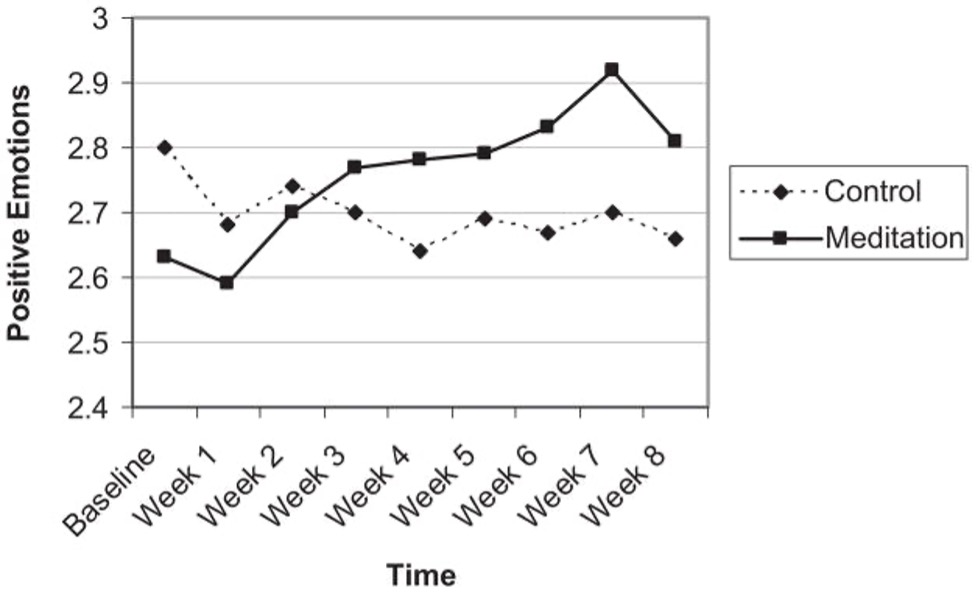
Long Description
The image is a line graph showing the change in positive emotions over time, tracked from baseline through week 8. The y-axis represents “Positive Emotions” with values ranging from 2.4 to 3, while the x-axis represents “Time” with intervals labeled as Baseline, Week 1 through Week 8. Two lines are plotted: a dotted line with diamond markers representing the control group, and a solid line with square markers representing the meditation group. The meditation group shows a notable increase in positive emotions starting from a lower baseline, peaking at week 7, and then slightly declining in week 8. The control group remains relatively stable with minor fluctuations. A legend in the upper right corner identifies the lines.
Reproduced from “Open hearts build lives: Positive emotions, induced through loving-kindness meditation, build consequential personal resources” by B.L. Fredrickson, M.A. Cohn, M.A., K.A. Coffey, J. Pek, and S.M. Finkel, 2008, Journal of Personality and Social Psychology, 95(5), p. 1052 (https://doi.org/10.1037/a0013262) Copyright 2008 by the American Psychological Association.
This same analysis was conducted for the average of the negative emotions. Surprisingly, time and experimental group did not impact negative emotions. Said another way, engaging in LKM did not change the amount of negative emotions people reported. So, LKM increased positive emotions, but did not decrease negative emotions!
Interestingly, further analysis showed that LKM did not significantly increase any specific positive emotion. Instead, LKM increased positive emotion experiences as a group (Figure 28).
Figure 28
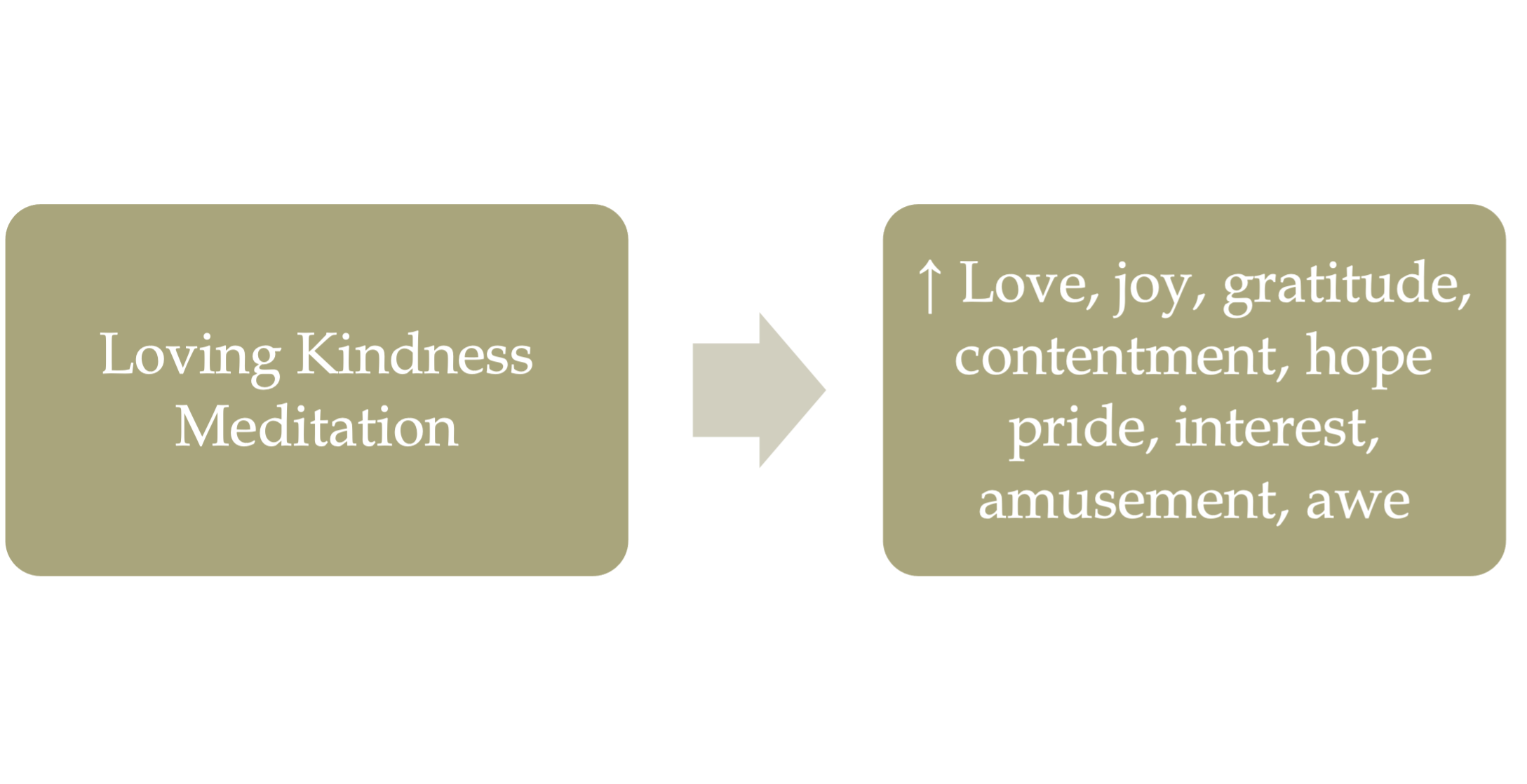
The next analysis evaluated two casual linkages by comparing self-reports as week 8 to self-reports at baseline (Figure 29):
- Change in Positive Emotions Causing a Change in Personal Resources
- Change in Personal Resources Causing a Change in Satisfaction with Life
The above two casual linkages were significant for 9 personal resources: mindfulness, pathways thinking, savoring the future, environment mastery, self-acceptance, purpose in life, social support received, positive relationships with others, and illness symptoms.
Figure 29
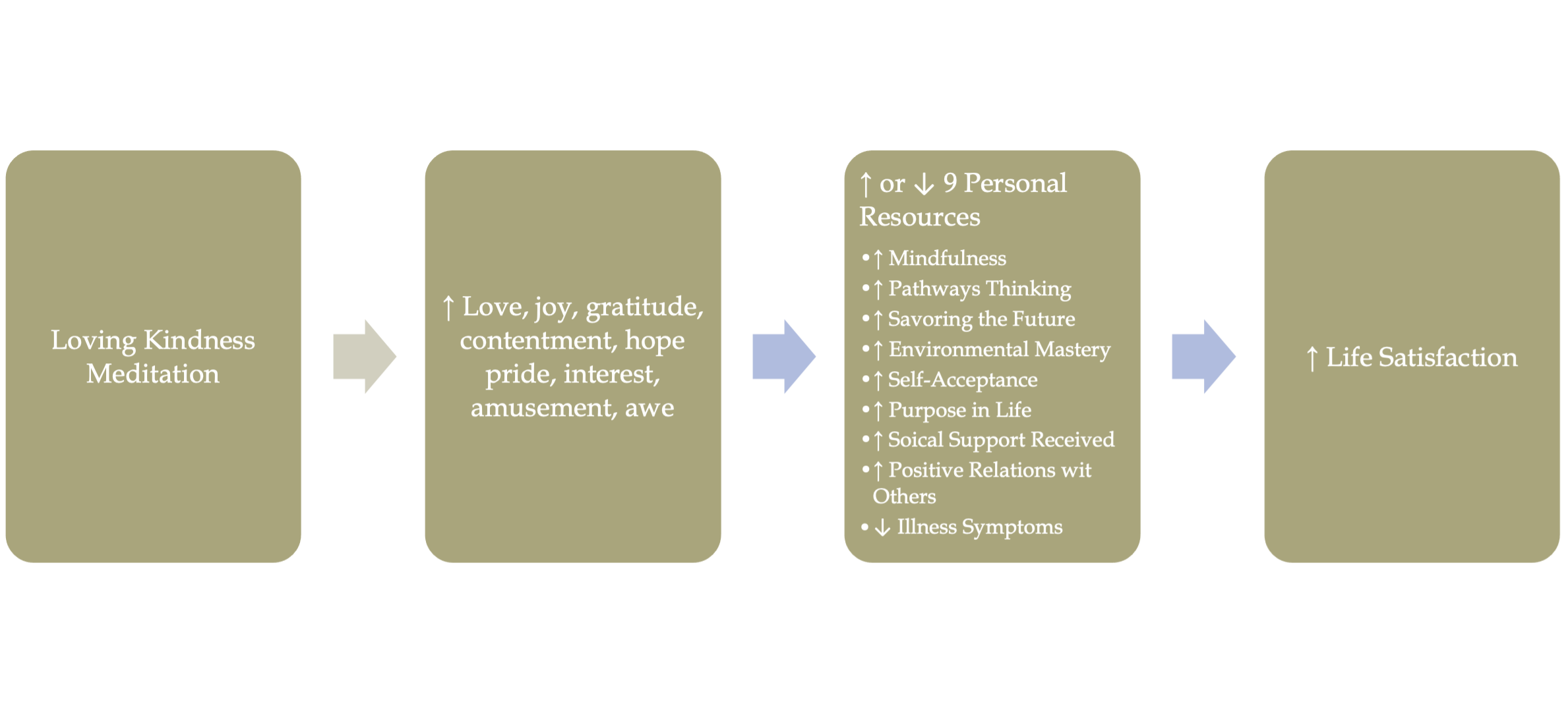
Long Description
The image is a flow diagram consisting of three olive-green rectangles connected by arrows. The first rectangle on the left is labeled “Loving Kindness Meditation.” An arrow points to the middle rectangle labeled with various positive emotions: “Love, joy, gratitude, contentment, hope, pride, interest, amusement, awe.” Another arrow leads to the third rectangle labeled “or ↓ 9 Personal Resources” with a list of items, followed by an arrow pointing to the final rectangle, labeled “Life Satisfaction.” The background of the image is white.
Figure 30
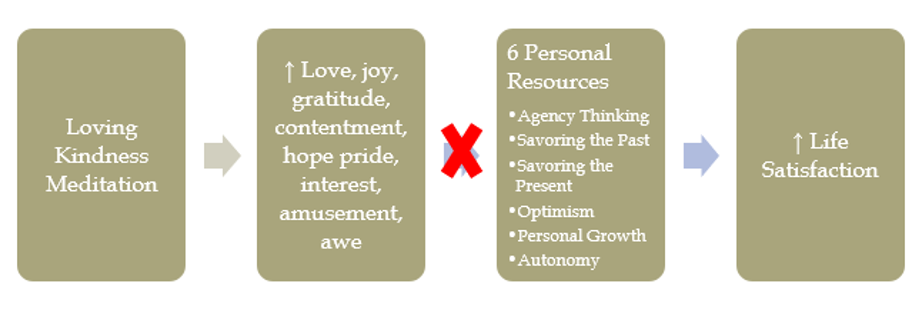
Long Description
The image is a flowchart consisting of four taupe rectangles connected by arrows, illustrating a process. From left to right, the first rectangle labeled “Loving Kindness Meditation” is followed by a rightward arrow pointing to the second rectangle, which lists emotions: “↑ Love, joy, gratitude, contentment, hope, pride, interest, amusement, awe.” This rectangle is intersected by a red “X,” which connects to a third rectangle labeled “6 Personal Resources” listing: “Agency Thinking, Savoring the Past, Savoring the Present, Optimism, Personal Growth, Autonomy.” An arrow continues from this rectangle to the fourth one, labeled “↑ Life Satisfaction.”
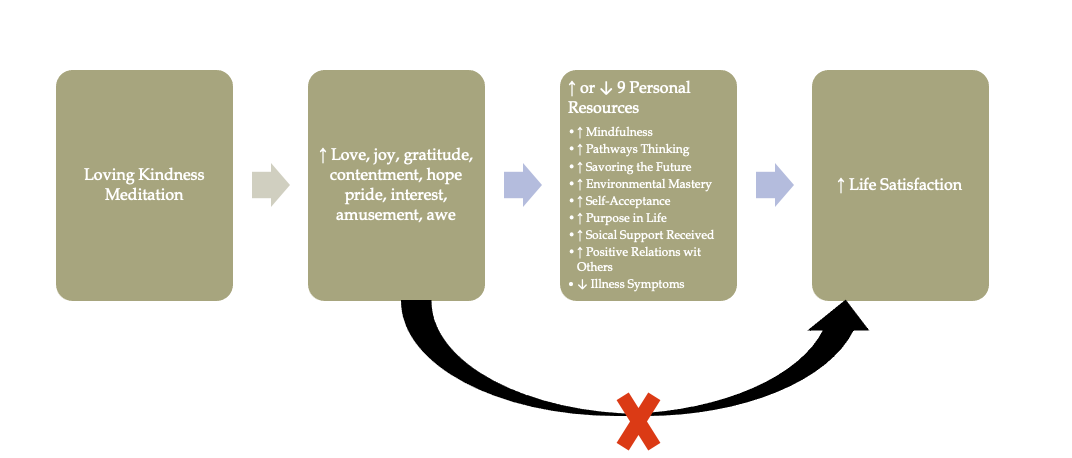
Long Description
The image is a flowchart consisting of four taupe rectangles connected by arrows, illustrating a process. From left to right, the first rectangle labeled “Loving Kindness Meditation” is followed by a rightward arrow pointing to the second rectangle, which lists emotions: “↑ Love, joy, gratitude, contentment, hope, pride, interest, amusement, awe.” This rectangle is intersected by a red “X,” which connects to a third rectangle labeled “6 Personal Resources” listing: “Agency Thinking, Savoring the Past, Savoring the Present, Optimism, Personal Growth, Autonomy.” An arrow continues from this rectangle to the fourth one, labeled “↑ Life Satisfaction.”
Figure 32

Long Description
The image is a flowchart consisting of four rectangular sections, each with an arrow indicating progression. The sections, in a muted olive color, are sequentially connected by gray arrows. The first section, “Loving Kindness Meditation,” leads to the second, “↑ Love, joy, gratitude, contentment, hope, pride, interest, amusement, awe.” This is followed by the third, “↑ or ↓ 9 Personal Resources,” which lists several resources with upward and downward indicators. Finally, the fourth section states “↑ Life Satisfaction.” Underneath the main flow, green and black curved arrows connect the “Loving Kindness Meditation” box to the “Life Satisfaction” box, bypassing the intermediate steps. Red X marks overlay the intermediate connections, focusing attention on the direct connection.
Figure 33
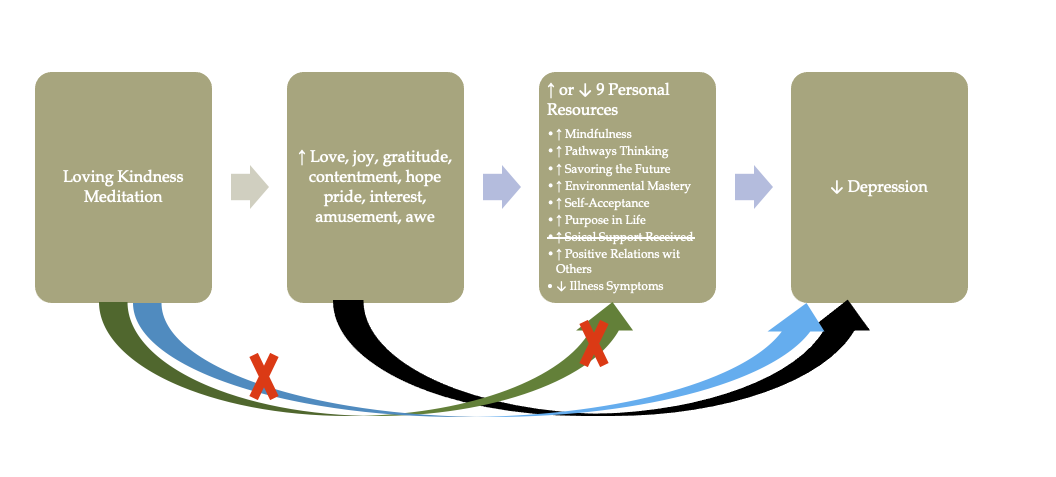
Long Description
The image is a flowchart with four beige, rectangular boxes arranged in a horizontal line. The sequence indicates a progression of concepts. The first box on the left is labeled “Loving Kindness Meditation,” followed by the second box labeled “↑ Love, joy, gratitude, contentment, hope, pride, interest, amusement, awe.” An arrow points from the first to the second box, showing a movement to positive emotions. The third box is labeled “↑ or ↓ 9 Personal Resources” and includes a list of personal resources with arrows indicating increase (↑) or decrease (↓), such as “Mindfulness” and “Environmental Mastery. “Social Support Received” is crossed out. The fourth box, labeled “↓ Depression,” concludes the sequence with an arrow from the third box. Curved arrows beneath the boxes, colored green, blue, and black, indicate alternative paths, with red Xs marking paths not continued onto the next stages.
Figure 34
Pictorial Display of Fredrickson et al. (2008) Results for Broaden-and-Build Theory
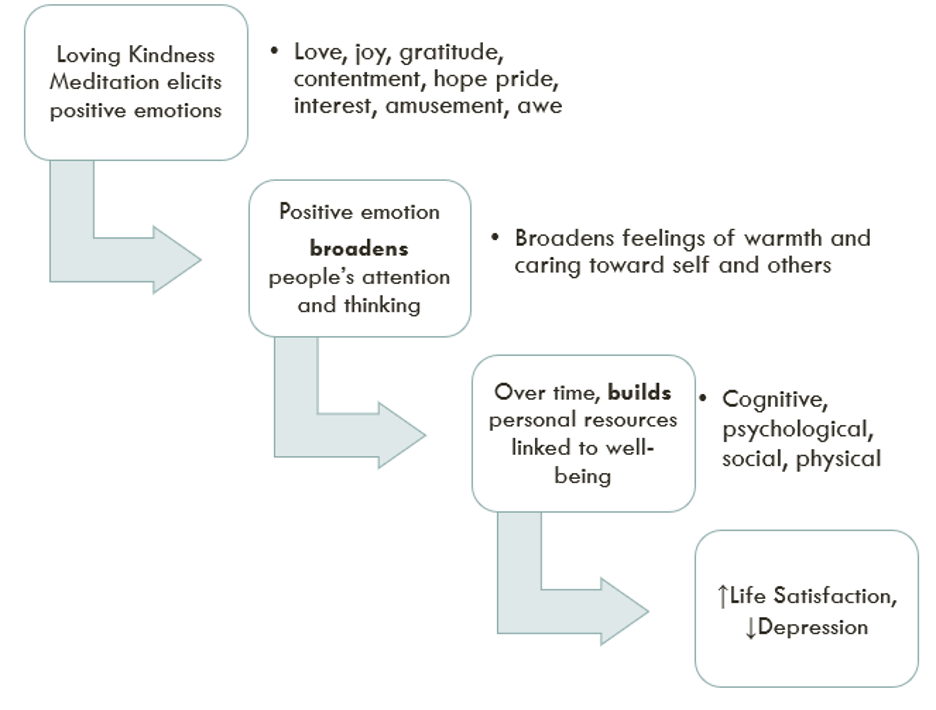
Long Description
The image is a flowchart illustrating the benefits of Loving Kindness Meditation on emotions and personal resources. It starts with a rectangular box on the left containing the text “Loving Kindness Meditation elicits positive emotions,” followed by an arrow pointing to the next box to the right. This box contains bullet points listing positive emotions: “Love, joy, gratitude, contentment, hope pride, interest, amusement, awe.” Below it, another box states “Positive emotion broadens people’s attention and thinking.” An arrow points to the next box to the right, which reads “Broadens feelings of warmth and caring toward self and others.” Another arrow points downward to a box housing the text, “Over time, builds personal resources linked to well-being,” and another arrow points rightward to the final box, saying “Cognitive, psychological, social, physical.” Below it, a separate box states “↑ Life Satisfaction, ↓ Depression.”
Table(s) 31 displays the four types of personal resources identified in research.
| Cognitive |
|---|
|
| Psychological |
|---|
|
| Social |
|---|
|
| Physical |
|---|
|
Adapted from “Positive emotions” by B.L. Fredrickson and M.A. Cohn, , 2008, In M. Lewis, J.M. Haviland-Jones, and L.F. Barrett Handbook of Emotions (3rd Edition, p. 786-789). Copyright 2008 Guilford Press.
| Positive Emotion | Broadens Thoughts or Behaviors | Builds Personal Resources |
|---|---|---|
| Love | Any / all of the below, with mutual care | Any / all of the below, with social bonds |
| Joy | Play, get involved | Skills gained via experiential learning |
| Gratitude | Creative urge to be prosocial | Skills for showing care, loyalty, social bonds |
| Serenity / Contentment | Savor and integrate | New priorities or views of the self |
| Interest | Explore, learn | Knowledge |
| Hope | Plan for a better future | Resilience, optimism |
| Pride | Dream big | Achievement motivation |
| Amusement | Share, joviality, laugh | Social bonds |
| Inspiration | Strive toward own higher ground | Motivation for personal growth |
| Awe | Absorb and accommodate | New worldviews |
Note. Listed from most frequently experienced to rarely experienced. “Positive emotions broaden and build,” by B.L. Fredrickson, In P. Devine and A. Plant (Eds.) Advances in Experimental Social Psychology, 47, p. 4, 6, Copyright 2013 Academic Press
In this Yale Experts in Emotion video, Barbara Fredrickson discusses how her undoing effect of positive emotions led to the development of the broaden-and-build theory. She also discusses her view on whether positive emotions are discrete or often co-occur. Start around 3:00 and end around 13:22.
Yale Experts in Emotion Video on Barbara Fredrickson

